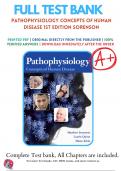Exam (elaborations)
Test Bank Pathophysiology Concepts of Human Disease 1st Edition Matthew Sorenson Chapter 1-53 | All Chapters
- Course
- Institution
- Book
Master pathophysiology for nursing exams with the comprehensive Test Bank for 'Pathophysiology Concepts of Human Disease, 1st Edition' by Matthew Sorenson. This instant PDF download, sourced directly from the publisher, covers all 53 chapters, providing complete Questions and Answers. Print it for ...
[Show more]



